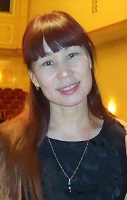The semantics of the structural elements in Tuvan dance
DOI:
https://doi.org/10.25178/nit.2019.1.13Keywords:
Tuvan dance; Tuvans; Tuva; rite; ritual; body language; dance; sacred gesture; sacred geometry; khuresh; dance of the eagleAbstract
The article presents an analysis of the dance gestures and the geometry of dance as ritual and ceremonial heritage of Tuvans. Dance is understood as an integral cultural phenomenon with its own rituals and ceremonial, as well as motions, posture and gestures related to household, employment, games etc. All of these are filled with ethnic and cultural meanings and associated with a specific ethnocultural identity. The structural-semantic approach makes it possible to analyze dance as a language expressed by the semantics of its gestures. The study’s source base includes published works on traditional ceremonies of Tuvans and peoples of related ethnic culture; and also materials of field studies conducted in Mongolia among ethnic Tuvans in 2018.
Kinetic traditions of Tuvan dance can be said to "remember" and "preserve" mythological subjects. The Tep traditional Tuvan dance features trampling movements akin to those made by sacred animals (deer, mountain goats, etc.). The rite of syg kezherde yөreёl contains dance moves with feet making geometric shapes on the ground. The dance figure of circular rotations has links with the solar cult, and the semantics of the legs — with the totem kinesics.
The Devig ritual dance – also known as the "dance of the eagle" - features interesting hand gestures. Swinging their hands like flapping birds’ wings, wrestlers thank Tengri, the creator deity of the sky. Touching the ground with the hand is an expression of deep respect to mother earth. The tradition of circular movements and circular composition appears in the Tuvan dance of Cheler-Oi.
References
Abaidulin, A. (1987) Tuvinskaia khoreografiia — istoki i perspektivy. Tvorchestvo naroda [Tuvan choreography, its origins and prospects. Creativity of the people]. Tuvinskaia pravda, 12 Februray, p. 3. (In Russ.).
Abaev, N. V. (2010) Tengrianstvo i rannie formy religii tiurko-monogol'skikh narodov Altai-Baikalii [Tengrianism and early forms of religion of the Turkic-Mongolian peoples of Altai-Baikal]. Kyzyl, TyvGU Publ. 131 p. (In Russ.).
Vainshtein, S. I. (1991) Mir kochevnikov Tsentra Azii [The world of nomads in the center of Asia]. Moscow, Nauka Publ. 272 p. (In Russ.).
Vorontsov, V. A. (2018) Istoki iskusstva generalizovannoi trudovoi teorii antroposotsiokul'turogeneza [The origins of the art of generalized labor theory of anthroposociocultural genesis]. Kazan', Tsentr innovatsionnykh tekhnologii. 304 p. (In Russ.).
Gumilev, L. N. (2002) Drevnie tiurki [Göktürks]. 2nd ed. Moscow, Airis-press. 504 p. (In Russ.).
Danchai-ool, A. A. (2016) Transformatsiia kul'turno-istoricheskoi traditsii v usloviiakh globalizatsii [Transformation of cultural and historical tradition in the context of globalization]. In: Aktual'nye problemy issledovaniia etnoekologicheskikh i etnokul'turnykh traditsii narodov Saiano-Altaia, posviashchennoi godu gostepriimstva v Respublike Tyva [Urgent issues of research of ethno-ecological and ethno-cultural traditions of the peoples of Sayano-Altai, devoted to the year of hospitality in the Republic of Tuva]: Proceedings of the 4th international research conference of young scientists, postgraduates and students / ed. by U. V. Ondar. Kyzyl, Tuvan State University. 227 p. Pp. 36–37. (In Russ.).
Dashieva, L. D. (2007) Buriatskii krugovoi tanets ekhor: istoriko-etnograficheskii, ladovyi, ritmicheskii aspekty [Buryat circular dance ekhor: historical-ethnographic, modal and rhythmic aspects]: Diss. … Candidate of Arts. Novosibirsk. 268 p. (In Russ.).
Devlet, E. G. and Devlet, M. A. (2005) Mify v kamne [Myths in stone]. Moscow, Aleteia. 471 p. (In Russ.).
Kuzhuget, A. K. (2005) Kul'tura i iskusstvo TNR [Culture and art of the PRT]. Uchenye zapiski, vol. XX. Kyzyl, Tuvinskii institut gumanitarnykh issledovanii. 420 p. Pp. 192–213. (In Russ.).
Kuzhuget, A. K (2016) Dukhovnaia kul'tura tuvintsev: struktura i transformatsiia [Spiritual culture of Tuvans: structure and transformation]. Krasnoiarsk : Ofset. 320 p. (In Russ.).
Kukhta, M. S. (2004a) Vospriiatie vizual'noi informatsii: filosofiia protsessa [Perception of visual information: the philosophy of the process]. Tomsk, Izdatel'stvo Tomskogo gosudarstvennogo pedagogicheskogo universiteta. 202 p. (In Russ.).
Kukhta, M. S. (2004b) Polifoniia smyslov: postneklassicheskaia interpretatsiia prostranstva mifa [The polyphony of the senses: post-non-classical interpretation of the space of myth]. Polignozis, no. 2, pp. 21–26. (In Russ.).
Kyrgys, Z. K. (2002) Tuvinskoe gorlovoe penie [Tuvan throat singing]. Novosibirsk, Nauka. 236 p. (In Russ.).
Lotman, Iu. M. (1996) Vnutri mysliashchikh mirov. Chelovek — tekst — semiosfera — istoriia [Inside thinking worlds. Man — text — semiosphere-history]. Moscow, Iazyki russkoi kul'tury. 445 p. (In Russ.).
Mainy, Sh. B. (2014) Narodnye igry v traditsionnoi prazdnichnoi kul'ture tuvintsev: istoriko-kul'turologicheskii analiz [Traditional games in the traditional festive culture of the Tuvans: historical-cultural analysis]: Diss. … Candidate of Culture study. Kemerovo. 186 p. (In Russ.).
Malikov, U. V. (2012) Mif i tanets. Opyt zanimatel'noi germenevtiki [Myth and dance. An attempt at an entertaining hermeneutics] / ed. by M. S. Kukhta. Moscow, Kanon+ ; ROOI «Reabilitatsiia». 304 p. (In Russ.).
Ondar, I. O. (2016) Genezis i transformatsiia tuvinskogo tantsa v kul'ture Tuvy [Genesis and transformation of folk dance in the culture of Tuva]: Diss. … Candidate of Culture study. Krasnoiarsk. 205 p. (In Russ.).
Russko-tuvinskii slovar' [A Russian-Tuvan dictionary] (1980) / ed. by D. A. Mongush. Moscow, Russkii iazyk. 560 p. (In Russ.).
Sagdy, K. Ch. (1973) Istoriia vozniknoveniia tuvinskogo teatra [A history of the Tuvan theatre]. Kyzyl, The Tuva book publishing house. 140 p. (In Russ.).
Samzhid, R. (2014) Khün baigaliin shüteltsee bai mongol büzhgiin garal üüsel, khögzhliin ukhaand [On the origins of Mongolian dance and its relationship with nature]. In: Tanets kak istoriko-kul'turnoe nasledie mongoloiazychnykh narodov [Dance as a historical and cultural heritage of the Mongolian peoples] : Materials of the International research conference dedicated to the 75th anniversary of P. T. Nadbitov and 57th anniversary of his creative work / ed. by N. G. Ochirova. Elista, KIGI RAN. 262 p. Pp. 68–77. (In Mongolian).
Samdan, Z. B. (2018) Aktual'nye voprosy sokhraneniia traditsionnoi kul'tury tuvintsev (na materiale mifologicheskikh i fol'kloristicheskikh istochnikov) [Topical issues of preservation of traditional culture of Tuvans: mythological and folkloristic sources)]. In: Sovremennye etnicheskie protsessy i tendentsii v Tsentral'noi Azii i Mongolii [Contemporary ethnic processes and trends in Central Asia and Mongolia]: International research conference / ed. by U. V. Ondar. Kyzyl, Tuvan State University. 235 p. Pp. 229–233. (In Russ.).
Sanchai, Ch. Kh. (2014) «Tanets orla» — dukhovno-khudozhestvennoe nasledie tuvinskogo naroda [The "dance of the eagle” as spiritual and artistic heritage of Tuvan people]. The New Research of Tuva, no. 1 [online] Available at: https://nit.tuva.asia/nit/article/view/180 (access date: 24.04.2018). (In Russ.).
Sanchai, Ch. Kh. (2016) Kul'turnye predposylki vozniknoveniia tuvinskogo khorovodnogo tantsa «Cheler-oi» [The cultural background of the Tuva Celer-Oi round dance]. GAUDEAMUS IGITUR. Sovremennye gumanitarnye issledovaniia, no. 3, pp. 52–56. (In Russ.).
Sanchai, Ch. Kh. and Kukhta, M. S. (2016) Simvolicheskaia plastika v tantseval'noi kul'ture tuvintsev [Symbolic plastics in the dance culture of Tuvans]. In: Aktual'nye problemy issledovaniia etnoekologicheskikh i etnokul'turnykh traditsii narodov Saiano-Altaia [Urgent issues of research in ethno-ecological and ethno-cultural traditions of the peoples of Sayano-Altai]: proceedings of the 4th international research conference of young scientists, postgraduates and students, dedicated to the year of hospitality in the Republic of Tuva / ed. by U. V. Ondar. Kyzyl, Tuvan State University. 227 p. Pp. 61–62. (In Russ.).
Sevortian, E. V. (1980) Etimologicheskii slovar' tiurkskikh iazykov. Obshchetiurkskie i mezhtiurkskie osnovy na bukvu «V», «G», «D» [Etymological dictionary of Turkic languages. Turkic and inter-Turkic roots, letters “B”, “G”, “D”]. Moscow, Nauka. 768 p. (In Russ.).
Skifo-khunno-tiurkskie korni tuvinskoi sud'by [Scythian-Hun-Turkic roots of Tuvan destiny] (2007). In: Uriankhai. Tyva depter : Antologiia nauchnoi i prosvetitel'skoi mysli o drevnei tuvinskoi zemle i ee nasel'nikakh, ob Uriankhae – Tannu-tuve, uriankhaitsakh – tuvintsakh, o drevnostiakh Tuvy. [Uryankhai. Tuva depter: an anthology of scientific and educational thought about the ancient Tuvan land and its inhabitants, about Uryankhai – Tannu-Tuva, uryankhai – Tuvans, about the antiquities of Tuva]: in 7 vols. / comp. by S. K. Shoigu. Moscow, Slovo. 592 p. Vol. 1. Drevnie plemena Tuvy i sopredel'nykh territorii Tsentral'noi Azii (II tysiachiletie do n. e. — konets XIX v.) [Ancient tribes of Tuva and adjacent territories of Central Asia (second Millennium BC — the end of XIX century)]. 592 p. Pp. 21–120. (In Russ.).
Saussure, F. de. (1977) Trudy po iazykoznaniiu [Works in linguistics] / transl. from French, ed. by A. A. Kholodovich. Moscow, Progress. 695 p. (In Russ.).
Struchkova, N. A. (2000) Semantika osnovnykh dvizhenii iakutskogo khorovodnogo tantsa osuokhai [The semantics of the basic movements of the Yakut round dance osuokhai]: Diss. … Candidate of History. Iakutsk. 188 p. (In Russ.).
Sultangareeva, R. A. (2013) Tantseval'nyi fol'klor bashkir [The dance folklore of the Bashkirs]. Ufa, Gilem; Bashkirskaia entsiklopediia. 128 p. (In Russ.).
Tatarintsev, B. I. (2002) Etimologicheskii slovar' tuvinskogo iazyka [An etymological dictionary of the Tuvan language]: in 4 vol. Novosibirsk, Nauka. Vol. II. 389 p. (In Russ.).
Traditsionnaia kul'tura tuvintsev glazami inostrantsev (konets XIX — nachalo XX veka) [Tuvan traditional culture through the eyes of foreigners (late 19th — early 20th century)] (2003) / preparation of texts, preface and commentary by A. K. Kuzhuget. Kyzyl, The Tuva book publishing house. 224 p. (In Russ.).
Tuvinsko-russkii slovar' [A Tuvan-Russian dictionary] (1955) / ed. by A. A. Pal'mbakh. Moscow, Gosudarstvennoe izdatel'stvo inostrannykh i natsional'nykh slovarei. 724 p. (In Russ.).
Freidenberg, O. M. (1998) Mif i literatura drevnosti [Myth and literature of antiquity]. 2nd ed. Moscow, Vostochnaia literatura. 799 p. (In Russ.).
Kharunova, M. M.-B. (2010) Problemy vozrozhdeniia natsional'noi kul'tury v Tuve v postsovetskii period [Problems of reviving ethnic culture in post-Soviet Tuva]. The New Research of Tuva, no. 2 [online] Available at: https://nit.tuva.asia/nit/article/view/525 (access date: 05.01.2019). (In Russ.).
Eliade, M. (2000) Shamanizm: Arkhaicheskie tekhniki ekstaza [Shamanism: Archaic techniques of ecstasy]. Kiev, Sofiia. 480 p. (In Russ.).
Khomushku, O. M. (2013) Religioznye traditsii narodov Saiano-Altaia kak faktor formirovaniia etnoekologicheskoi kul'tury [The religious traditions of the peoples of the Sayan-Altai Republic as a factor in the rise of ethno-ecological culture]. Mir nauki, kul'tury, obrazovanie, no. 6 (43), pp. 489–492. (In Russ.).
Lee, Hee Jung (2006) Storytelling of the Korean traditional dance «The Hahoe Mask» using interactive multimedia. Thesis. Rochester Institute of Technology [online] Available at: https://scholarworks.rit.edu/cgi/viewcontent.cgi?referer=https://www.google.com/&httpsredir=1&article=7306&context=theses (access date: 13.12.2018).
Sanchay, Ch. (2017) Semantics of Dance and Symbolic Plastic Movements in Tuvan Ceremonial System. Zhurnal Sibirskogo federal'nogo universiteta. Seriia: Gumanitarnye nauki, vol. 10, no. 7, pp. 1002–1006.
Published
How to Cite
Sanchai Ch. H., Kuchta M. S. The semantics of the structural elements in Tuvan dance. The New Research of Tuva, 2019, № 1. URL: https://nit.tuva.asia/nit/article/view/820 (дата обращения: дд.мм.гг.). DOI: 10.25178/nit.2019.1.13
Issue
Section

Author(s) license holder(s) grant rights for their work to the journal (grantee of a license) under the simple non-exclusive open license in accordance with Art. 1286.1 «Open license for a research work, work of literature or fine arts», Civil Code of the Russian Federation.
New Research of Tuva publishes articles under the Creative Commons Attribution-NonCommercial license (CC BY-NC).
Since it is an open license, author(s) reserve the right to upload the article to their institutional repository, submit it to another journal (if it allows republications), or republish it on their own website (in full, or in part).
However, several conditions apply here:
a) The republished version must always contain the name(s) and affiliation(s) of the author(s), the original title and the hyperlink to the original version on the New Research of Tuva website;
b) It must be in open access, free of charge, and no category of readers must be in any way whatsoever advantaged over general readership.
c) should the contribution be submitted elsewhere by its author(s) without substantial modification (30% or more of original text unchanged), the body of the article should contain a disclaimer that the original version was published in New Research of Tuva (with a link to the respective page)
The CC-BY-NC is a non-revocable license which applies worldwide and lasts for the duration of the work’s copyright.










